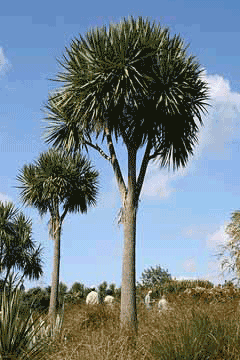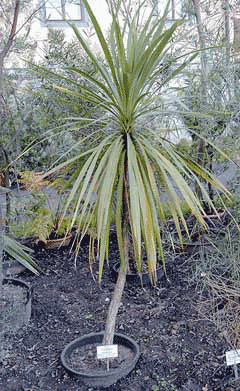 |
|
|
 |
| http://commons.wikimedia.org/wiki/User:Carstor |
Translate this page:
Summary
Sometimes misspelt as Corydeline australis
Physical Characteristics

 Cordyline australis is an evergreen Tree growing to 15 m (49ft) by 5 m (16ft) at a slow rate.
Cordyline australis is an evergreen Tree growing to 15 m (49ft) by 5 m (16ft) at a slow rate.
See above for USDA hardiness. It is hardy to UK zone 8 and is not frost tender. It is in leaf all year, in flower from August to September. The species is hermaphrodite (has both male and female organs).
Suitable for: light (sandy) and medium (loamy) soils. Suitable pH: mildly acid, neutral and basic (mildly alkaline) soils. It can grow in semi-shade (light woodland) or no shade. It prefers moist soil. The plant can tolerate maritime exposure.
UK Hardiness Map
US Hardiness Map
Synonyms
Dracaena australis. Forst.f.
Plant Habitats
Woodland Garden Sunny Edge; Dappled Shade;
Edible Uses
Edible Parts: Leaves Root Shoots Stem
Edible Uses: Sweetener
Root - baked[105, 153, 173, 177]. It can also be brewed into an intoxicating drink[183]. Pith of the trunk - dried and steamed until soft[173]. Sweet and starchy, it is used to make porridge or a sweet drink[173]. The root and stems are rich in fructose, the yields compare favourably with sugar beet (Beta vulgaris altissima)[153]. Edible shoots - a cabbage substitute[105, 128, 173]. The leaves are very fibrous even when young, we would not fancy eating them[K].
References More on Edible Uses
Medicinal Uses
Plants For A Future can not take any responsibility for any adverse effects from the use of plants. Always seek advice from a professional before using a plant medicinally.
None known
References More on Medicinal Uses
The Bookshop: Edible Plant Books
Our Latest books on Perennial Plants For Food Forests and Permaculture Gardens in paperback or digital formats.

Edible Tropical Plants
Food Forest Plants for Hotter Conditions: 250+ Plants For Tropical Food Forests & Permaculture Gardens.
More

Edible Temperate Plants
Plants for Your Food Forest: 500 Plants for Temperate Food Forests & Permaculture Gardens.
More

More Books
PFAF have eight books available in paperback and digital formats. Browse the shop for more information.
Shop Now
Other Uses
Fibre Paper
The leaves contain saponins, but not in commercial quantities[153]. The leaves contain a strong fibre, used for making paper, twine, cloth, baskets, thatching, rain capes etc[1, 46, 61, 128, 153]. The whole leaves would be used for some of these applications. When used for making paper, the leaves are harvested in summer, they are scraped to remove the outer skin and are then soaked in water for 24 hours prior to cooking[189]. Carbon farming - Industrial Crop: fiber.
Special Uses
Carbon Farming Food Forest Scented Plants
References More on Other Uses
Cultivation details
Industrial Crop: Fiber Management: Standard Minor Global Crop
Prefers a good sandy loam rich in humus[1]. Succeeds in full sun or light shade[188]. A very wind hardy plant, tolerating maritime exposure[49, 166]. A very ornamental plant[1], it is not very cold-hardy, tolerating short-lived lows down to about -10°c[260]. It only succeeds outdoors in the milder areas of Britain[1, 11, 59]. It grows very well in Cornwall where it often self-sows[1, 11, 59]. A form with purplish leaves is hardier than the type and succeeds outdoors in Gloucestershire[11]. The flowers have a delicious sweet scent that pervades the air to a considerable distance[245]. Mice often kill young plants by eating out the pith of the stem[11]. Carbon Farming Cultivation: minor global crop. Management: standard.
Carbon Farming
-
Industrial Crop: Fiber
Clothing, rugs, sheets, blankets etc. Currently, almost none of our fiber are produced from perennial crops but could be!
-
Management: Standard
Plants grow to their standard height. Harvest fruit, seeds, or other products. Non-Destructive management systems.
-
Minor Global Crop
These crops are already grown or traded around the world, but on a smaller scale than the global perennial staple and industrial crops, The annual value of a minor global crop is under $1 billion US. Examples include shea, carob, Brazil nuts and fibers such as ramie and sisal.
References Carbon Farming Information and Carbon Sequestration Information
Temperature Converter
Type a value in the Celsius field to convert the value to Fahrenheit:
Fahrenheit:
The PFAF Bookshop
Plants For A Future have a number of books available in paperback and digital form. Book titles include Edible Plants, Edible Perennials, Edible Trees,Edible Shrubs, Woodland Gardening, and Temperate Food Forest Plants. Our new book is Food Forest Plants For Hotter Conditions (Tropical and Sub-Tropical).
Shop Now
Plant Propagation
Seed - pre-soak for about 10 minutes in warm water and sow in late winter to early spring in a warm greenhouse[78, 164]. The seed usually germinates in 1 - 3 months at 25°c[164]. There is usually a good percentage germination[78]. Prick out the seedlings into individual pots as soon as they are large enough to handle and grow them on in the greenhouse for at least their first winter. Plant out in late spring after the last expected frosts and give the plants some protection in their first winter outdoors[K]. Stem cuttings - cut off the main stem just below the head and then saw off 5cm thick blocks of stem and place them 3cm deep in pure peat in a heated frame. Keep them moist until they are rooting well, then pot them up into individual pots. Plant out in late spring after the last expected frosts. Suckers. These are best removed in early spring and planted out in situ. Protect the division from wind and cold weather and do not allow the soil to become dry until the plant is established. Divisions can also be potted up and grown on until established, planting them out in the summer.
Other Names
If available other names are mentioned here
Native Range
AUSTRALASIA: New Zealand
Weed Potential
Right plant wrong place. We are currently updating this section.
Please note that a plant may be invasive in one area but may not in your area so it's worth checking.
No
Conservation Status
IUCN Red List of Threatened Plants Status : This taxon has not yet been assessed

Growth: S = slow M = medium F = fast. Soil: L = light (sandy) M = medium H = heavy (clay). pH: A = acid N = neutral B = basic (alkaline). Shade: F = full shade S = semi-shade N = no shade. Moisture: D = dry M = Moist We = wet Wa = water.
Now available:
Food Forest Plants for Mediterranean Conditions
350+ Perennial Plants For Mediterranean and Drier Food Forests and Permaculture Gardens.
[Paperback and eBook]
This is the third in Plants For A Future's series of plant guides for food forests tailored to
specific climate zones. Following volumes on temperate and tropical ecosystems, this book focuses
on species suited to Mediterranean conditions—regions with hot, dry summers and cool, wet winters,
often facing the added challenge of climate change.
Read More
Expert comment
Author
(G.Forst.)Hook.f.
Botanical References
1144200
Links / References
For a list of references used on this page please go here
Readers comment